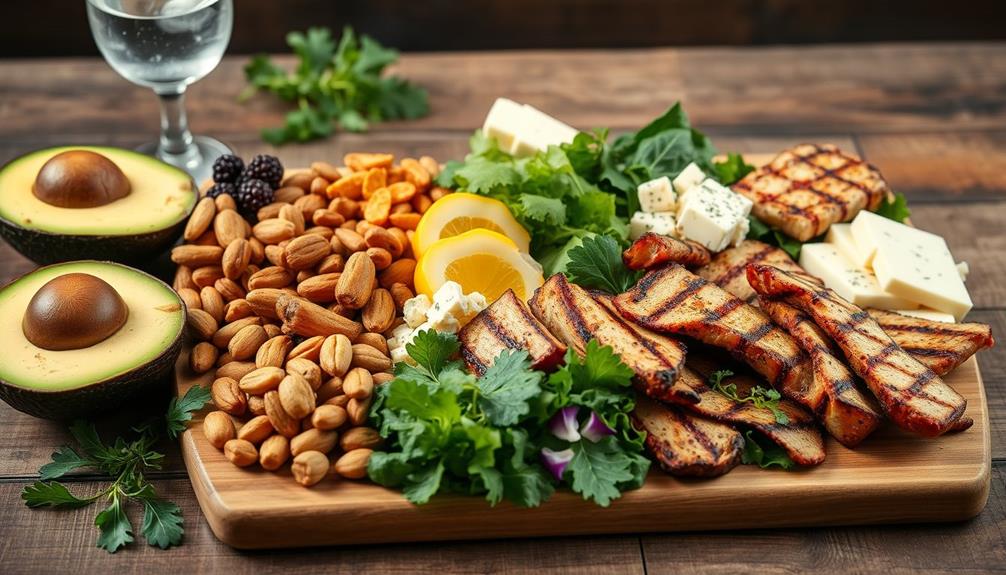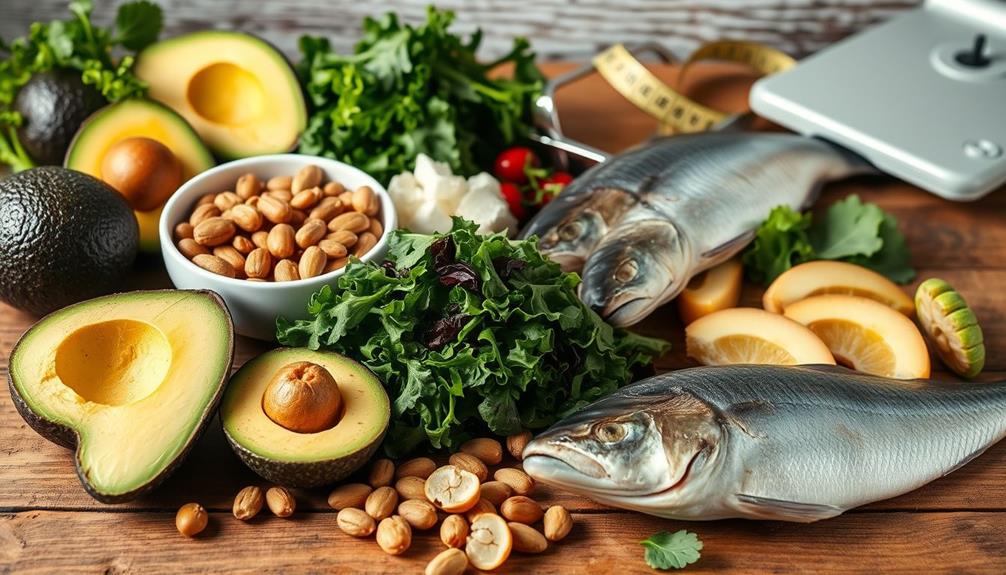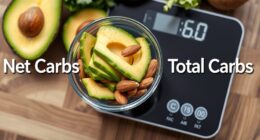To start the keto diet, focus on high-fat foods while keeping your carb intake low, ideally between 20-50 grams per day. Aim for meals with about 70% fat, 20% protein, and 10% carbohydrates. Include foods like avocados, nuts, and unprocessed meats while avoiding grains and sugary items. Meal prepping can help you stay on track, and be mindful of hidden carbs in sauces and processed foods. It's normal to face some initial side effects, like the "keto flu," but hydration and proper nutrient balance can ease the shift. Stick around, and you'll uncover more tips for successful keto living.
Key Takeaways
- Reduce carbohydrate intake to 20-50 grams per day to initiate ketosis, focusing on high-fat foods like avocados and fatty fish.
- Follow a macronutrient ratio of approximately 70% fat, 20% protein, and 10% carbohydrates for optimal results.
- Prepare meals in advance using batch cooking techniques to ensure you have keto-friendly options throughout the week.
- Stay hydrated and monitor electrolyte intake to manage potential side effects like the "keto flu" and digestive issues.
- Use resources such as expert guidelines and support groups to enhance your understanding and experience of the ketogenic diet.
Overview of the Keto Diet
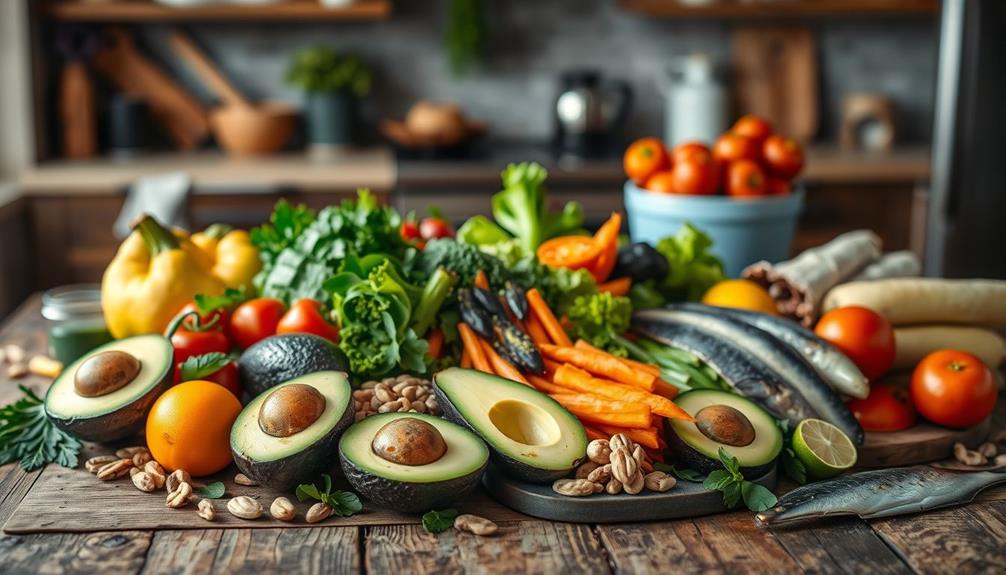
The ketogenic diet, which dates back to the 1920s, is a high-fat, low-carbohydrate eating plan designed to shift your body into a state of ketosis. This metabolic state occurs when you drastically reduce your carbohydrate intake to about 20-50 grams per day, prompting your body to burn fat for fuel instead of glucose.
As a result, your liver produces ketones, which serve as an alternative energy source for your brain and organs. To enhance your keto journey, it's crucial to incorporate regular physical activity to complement your dietary changes, as regular exercise to improve insulin sensitivity can further optimize your overall health.
A typical keto diet consists of approximately 70% fat, 20% protein, and only 10% carbohydrates. This means you'll need to avoid sugary foods, grains, and most fruits. Instead, focus on high-fat foods like avocados, nuts, seeds, and healthy oils, along with lean protein sources such as fish and poultry. In addition to changing your macronutrient ratios, it’s also important to stay hydrated and replenish electrolytes while on a keto diet. Many people find success with meal planning and tracking their macros to ensure they stay within their desired ratios. If you’re considering a keto diet, it can be helpful to seek out a keto diet success story to see how others have found success with this unique eating plan.
The ketogenic diet gained popularity for its effectiveness in weight loss and metabolic health improvement. Various versions exist, including the Standard Ketogenic Diet (SKD), which is the most commonly followed.
Whichever type you choose, understanding the principles behind the keto diet will help you make informed choices and optimize your chances of success in achieving your health goals.
Benefits of the Keto Diet
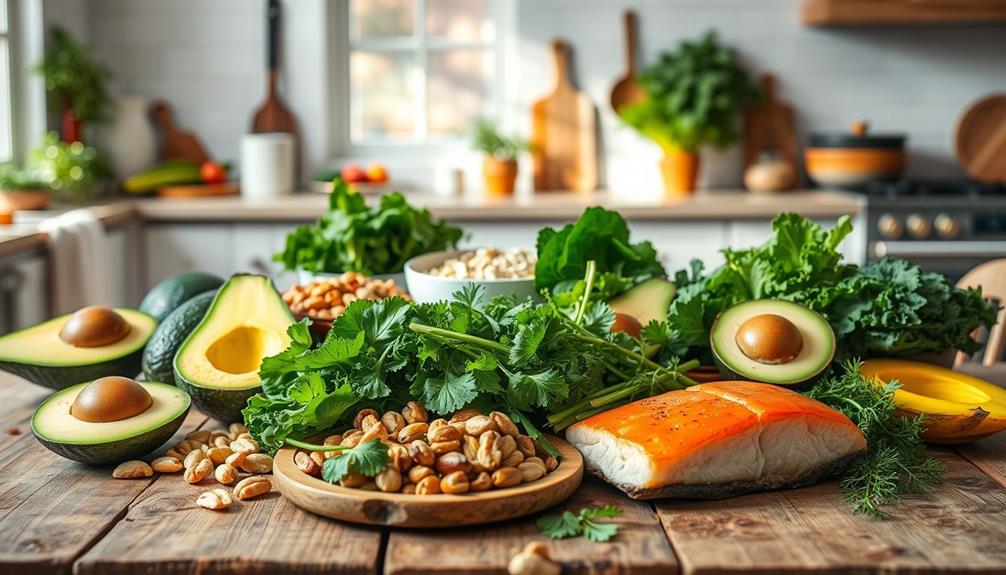
Keto enthusiasts often rave about the array of benefits that come with this low-carb, high-fat diet. One of the most notable advantages is significant weight loss. Studies show that participants on the ketogenic diet lose, on average, 2 pounds more than those on low-fat diets. This rapid weight loss can motivate you to stick with the plan.
Additionally, the keto diet can help improve blood sugar control, particularly for those with type 2 diabetes. About 60% of participants have even reversed their condition through adherence to this metabolic state called ketosis. As with any dietary change, it's important to monitor your overall nutrition and hydration levels to avoid potential deficiencies, similar to concerns related to juice diets.
You may also experience increased energy levels and enhanced mental clarity as your body efficiently uses fat for fuel.
Another compelling benefit is its potential to improve cholesterol levels. Research indicates that the ketogenic diet can lead to reduced triglycerides and increased HDL cholesterol, contributing to better heart health.
Finally, for those dealing with drug-resistant epilepsy, the ketogenic diet may reduce seizure frequency, offering an alternative treatment option.
Food Choices for Keto
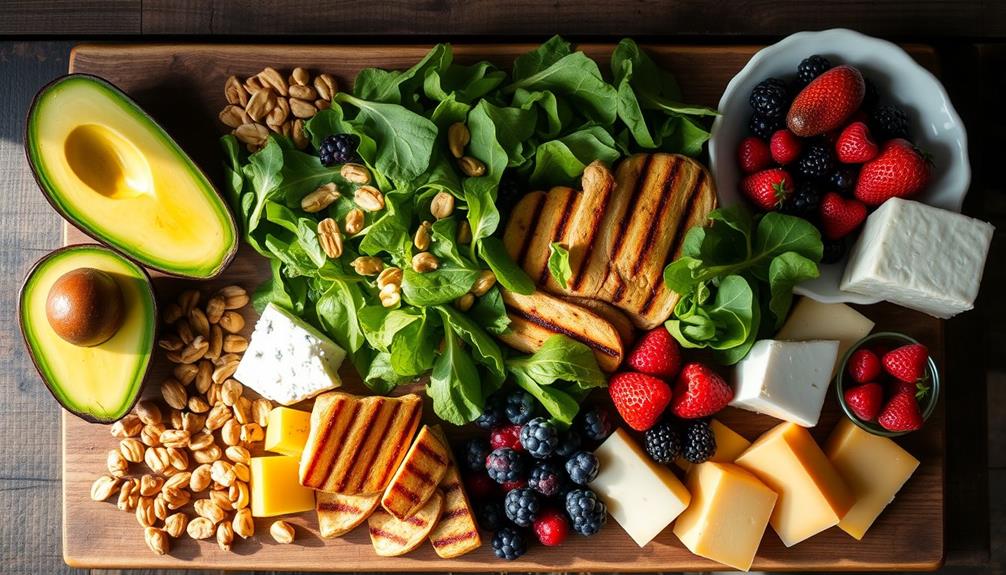
Starting on a ketogenic journey requires careful selection of food choices that align with your dietary goals. Focus on high-fat foods like avocados, nuts, seeds, olive oil, and fatty fish, which should constitute about 70-80% of your daily calorie intake.
Additionally, consider incorporating natural remedies alongside conventional methods to support your overall health during this shift. To succeed, limit your carbohydrate intake to 20-50 grams per day by avoiding grains, sugary foods, and most fruits. Instead, opt for low-carb vegetables like leafy greens and cruciferous options.
When it comes to proteins, choose unprocessed meats such as red meat, chicken, and fatty fish. Full-fat dairy products like cheese and butter will help maintain the high-fat ratio essential for the ketogenic diet.
Incorporate healthy snacks like cheese, pork rinds, or hard-boiled eggs to manage hunger and curb cravings for high-carb foods.
Be vigilant about hidden carbohydrates found in sauces, dressings, and packaged foods. Always check food labels to verify they align with keto guidelines.
Meal Planning Strategies
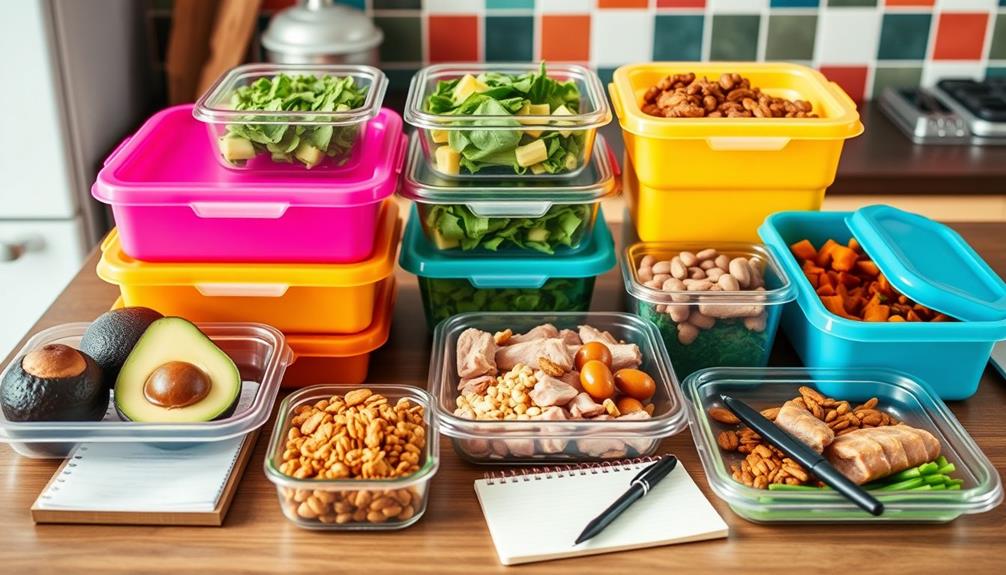
When you're planning your keto meals, smart grocery shopping is key to stocking your kitchen with the right ingredients. This includes understanding your budget and tracking expenses to guarantee you're making cost-effective choices for your meals, which aligns with the importance of a budget plan.
Try using meal prep techniques to make larger batches of keto-friendly dishes that you can enjoy throughout the week. This approach not only saves time but also keeps you on track with your dietary goals.
Grocery Shopping Tips
Grocery shopping for a keto diet requires a strategic approach to guarantee you stick to your low-carb goals. Start by making a detailed shopping list that focuses on high-fat foods like avocados, nuts, seeds, oils, and fatty cuts of meat. This ascertains you stick to keto-friendly options and avoid impulse buys.
Understanding the differences between products is vital; for instance, different brewing methods can affect the health benefits of your coffee choices, which can be a part of your keto lifestyle.
Familiarize yourself with food labels to spot hidden sugars and carbohydrates, keeping your total daily carb intake within the recommended 20-50 grams for effective ketosis. Planning your meals for the week, including breakfast, lunch, dinner, and snacks, will help you avoid unnecessary purchases and keep your pantry stocked with the right ingredients.
When you're in the store, shop the perimeter where fresh, whole foods are usually found and steer clear of the aisles filled with processed foods and high-carb items like grains and sugary snacks.
Additionally, consider bulk buying keto staples such as almond flour, coconut oil, and grass-fed butter. This not only saves you money but guarantees you always have these essential ingredients on hand for your weekly meals.
With these grocery shopping tips, you'll be well on your way to a successful keto journey!
Meal Prep Techniques
Meal prep techniques can transform your keto journey by streamlining your cooking process and keeping you on track with your dietary goals. Start by planning your meals for the week ahead. Create a detailed shopping list focused on high-fat options like meats and dairy, alongside low-carb vegetables. This guarantees you stay committed to the ketogenic diet.
Additionally, consider incorporating hamster care tips to understand the importance of proper nutrition and meal planning, which can be beneficial for any dietary approach.
Batch cooking is an effective strategy; prepare large quantities of keto-friendly recipes such as casseroles and soups. These can be portioned out and stored in meal prep containers for easy access on busy days. This not only simplifies your meal options but also helps with portion control, reducing the temptation to grab high-carb alternatives.
To keep things interesting, incorporate a variety of flavors and textures in your meal prep. Use herbs and spices creatively to enhance the appeal of low-carb ingredients. Dedicate a specific day for meal prepping, guaranteeing all your meals are ready for the week.
This proactive approach reduces the likelihood of making last-minute unhealthy choices and helps you stick to your healthy choices effortlessly.
Common Side Effects

As you start the ketogenic diet, you might experience what's commonly known as the "keto flu," which can bring on fatigue, headaches, and nausea.
It's also beneficial to incorporate gentle stretching before bedtime to relax your muscles and help with any discomfort.
Managing digestive issues, like constipation or bloating, is also important as your body adjusts to the higher fat intake.
Understanding these side effects can help you prepare for a smoother changeover into ketosis, especially if you consider yoga for back pain as a supportive practice during this time.
Keto Flu Symptoms
During the first few days of starting a ketogenic diet, you might experience a range of symptoms commonly referred to as the "keto flu." This collection of side effects, which can include fatigue, headache, nausea, dizziness, irritability, and muscle cramps, often results from your body adjusting to burning fat for fuel instead of carbohydrates.
These keto flu symptoms are typically linked to carbohydrate withdrawal and electrolyte imbalances. Understanding how to manage these symptoms effectively can be vital for a successful shift, much like caregivers managing financial considerations for elderly care to guarantee a smooth process.
As you move into ketosis, your body undergoes significant changes that can lead to discomfort. Fatigue and dizziness are common as your energy levels fluctuate. Nausea and irritability may also arise as your body craves the carbs it's used to.
Additionally, you might experience gastrointestinal issues like constipation, which can occur due to a lower fiber intake.
Staying hydrated and guaranteeing adequate intake of electrolytes—like sodium, potassium, and magnesium—can help alleviate these symptoms. While the majority of keto flu symptoms resolve within 3-4 weeks, you can ease the shift by gradually reducing your carbohydrate intake instead of making an abrupt switch.
This approach can help your body adapt more smoothly to the ketogenic lifestyle.
Managing Digestive Issues
Shifting to a ketogenic diet can lead to some digestive issues that might catch you off guard. Many people experience gastrointestinal discomfort during this adjustment, often referred to as "keto flu." About 20-30% of you might face symptoms like diarrhea, constipation, and bloating as your body adapts to higher healthy fats and lower carbs.
To help manage these issues, consider the following tips: Additionally, incorporating essential oils like peppermint oil, known for its soothing properties, can provide relief from digestive discomfort. You may also find that using essential oils for dizziness relief can help alleviate nausea associated with keto flu.
- Guarantee adequate fiber intake from low-carb vegetables, nuts, and seeds.
- Stay hydrated to support digestion and overall health.
- Monitor your electrolyte intake, especially sodium and potassium.
- Gradually introduce fats into your meals rather than diving into high-fat options all at once.
- Be patient with your body as it adapts to these dietary restrictions.
Long-term Considerations
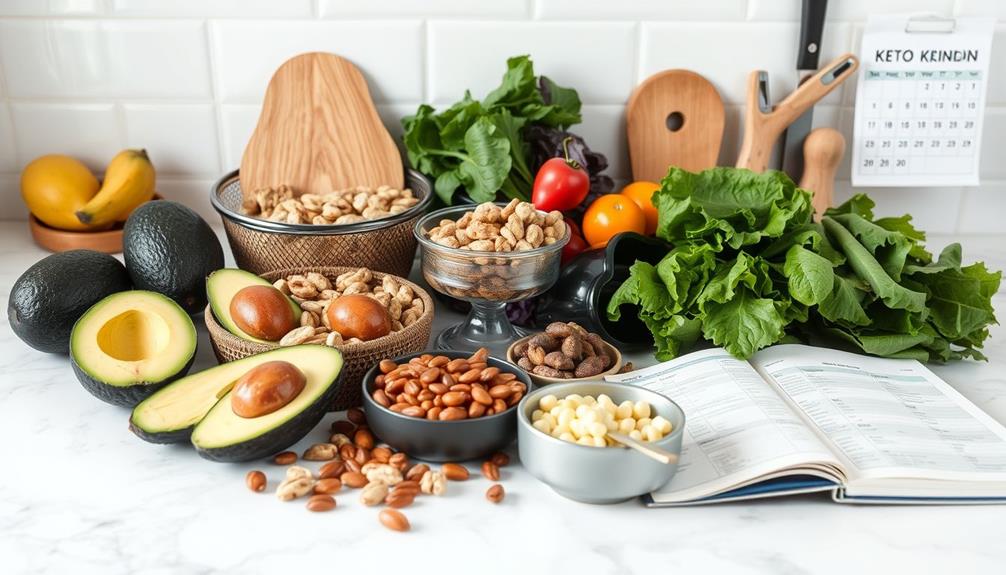
Long-term success on the ketogenic diet requires careful consideration and planning. As you commit to this lifestyle, it's essential to monitor and supplement your nutrient intake to prevent potential deficiencies. The restricted variety of foods can lead to imbalances, so regular health check-ups, including assessments of cholesterol levels, are important for tracking your overall health.
Additionally, incorporating strategies from other investment approaches, like those seen in Gold IRAs, can help create a more balanced and sustainable plan for your dietary investments.
To avoid weight regain, you need a sustainable plan that supports your long-term health goals. Implementing a more flexible approach, like a cyclical ketogenic diet, allows you to enjoy occasional higher-carb days during social events or intense workouts without derailing your progress. This flexibility can make the diet more enjoyable and manageable over time.
Additionally, moving to a balanced diet after following keto is significant. Incorporating whole foods and a diverse range of nutrients helps maintain your weight loss and promotes overall health.
Resources for Support

Finding reliable resources for support can make all the difference in your ketogenic journey.
Whether you're new to the Keto Diet or seeking to enhance your existing knowledge, tapping into expert guidelines and community motivation can be invaluable.
Here are some great resources to take into account:
- Cleveland Clinic & Mayo Clinic: These reputable sources offer expert guidelines on ketogenic nutrition.
- Johns Hopkins Medicine: Ideal for those with specific medical conditions, providing extensive materials on managing a ketogenic lifestyle.
- Familydoctor.org: Find practical tips and beginner-friendly advice to help you navigate dietary changes successfully.
- Online Support Groups: Engage with communities on social media platforms to foster motivation and share experiences.
- Health Tools & Calculators: Utilize online tools to track your daily macronutrient intake and monitor your progress.
Frequently Asked Questions
How Do I Start Going on Keto?
To start, calculate your daily caloric needs, then gradually reduce carbs while focusing on high-fat foods. Prepare meals in advance and stay hydrated to ease the change and maintain energy during this dietary shift.
What Are the Basic Rules of a Keto Diet?
"You are what you eat," so focus on drastically cutting carbs to 20-50 grams daily. Prioritize healthy fats, moderate protein, and stay hydrated. Keep an eye on electrolytes to avoid potential side effects!
What Is the Correct Way to Eat Keto?
To eat keto correctly, you'll drastically cut carbs to 20-50 grams daily while boosting healthy fats to 70-80% of your calories. Focus on high-fat foods, maintain protein intake, and stay hydrated for balance.
What Can Be Eaten on a Keto Diet?
On a keto diet, you can eat high-fat foods like avocados, nuts, and fatty fish. You'll enjoy meats, low-carb veggies, and dairy, but avoid grains, sugars, and most fruits. Stick to healthy fats! Transitioning to a keto diet may be challenging at first, as you may experience cravings for the foods you used to enjoy. However, once your body adapts to using fat for fuel instead of carbs, you will likely experience increased energy levels and mental clarity. It’s important to stay committed to the diet and focus on the delicious and satisfying foods that you are able to eat. With time and dedication, you’ll likely find that the benefits of a keto diet outweigh any initial challenges.
Conclusion
In the words of Benjamin Franklin, "An ounce of prevention is worth a pound of cure." Embracing the keto diet can lead to transformative health benefits, but it's essential to approach it with knowledge and planning. By understanding the food choices, meal strategies, and potential side effects, you're setting yourself up for success. Remember, it's not just about cutting carbs; it's about crafting a sustainable lifestyle that suits you. Stay informed and enjoy the journey!
